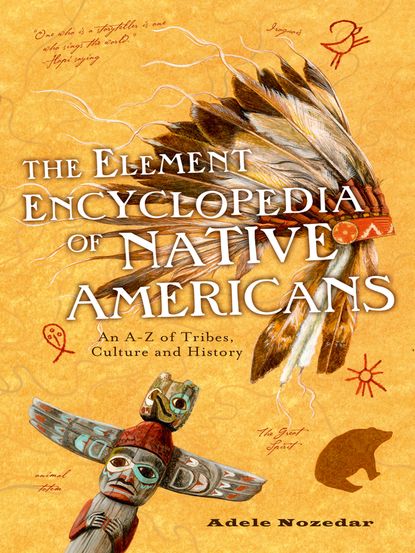По всем вопросам обращайтесь на: info@litportal.ru
(©) 2003-2024.
✖
The Element Encyclopedia of Native Americans: An A to Z of Tribes, Culture, and History
Настройки чтения
Размер шрифта
Высота строк
Поля
COUNTING COUP
This term referred to a piece of battle etiquette, and was a very important principle. The Assiniboin, for example, believed that “Killing an enemy counts for nothing unless that person is touched or struck.”
Victory over an enemy was “certified” by the first touch of that enemy, be it with a stick, the hand, or a weapon, while he was still alive. This initial contact constituted the first “coup”. If the enemy was subsequently killed after this touch, then this was the second coup. If the enemy was then scalped to boot, this counted as three coups.
Further, touching the tipi or home of the enemy counted as a coup, and any symbols painted on it could be appropriated by the victor. Stealing the enemy’s horse, too, counted as a further coup.
The greatest honor, though, was that initial touch, that contact with the living enemy. This was considered to be even more important than the killing. Considering this logically, it takes more nerve to have physical contact with a foe than it does to kill him from a distance, say, with a bow and arrow, or with a bullet from a gun.
Feathers or pelts were worn to indicate the number, and nature of, the coups. For example the Assiniboin warrior wore an eagle feather for each enemy that he had killed. A Crow warrior would attach wolf tails to the heels of his moccasins to indicate the same thing.
COUP STICK
A log stick, curved at one end and highly decorated, including with fur, which was used to “count coup” on an enemy. The coup stick was a highly valued object, especially if it had touched many enemies, and was passed down from father to son.
See alsoCounting Coup (#ulink_e96c3e67-fc07-568a-b07c-6deda2ccf9ce)
COUREUR DE BOIS
A French phrase meaning “runner of the woods.” The term referred to the French fur traders who were independent of the larger fur-trading organizations and preferred to work as sole operators, often living for the majority of their time with the local Native peoples.
COYOTE
The coyote, or prairie wolf, also known as the barking wolf because of the sound it makes, was respected by Native Americans for its perceived wisdom. In common with many other sacred animals, the flesh of the coyote was rarely eaten; however, a division of the Apache known as the Coyoteros are said to have that name purely because they did elect to eat the flesh of the animal.
Coyote skin was prized as a material for making the quivers that held arrows.
CRADLEBOARD
Still in use for many Native American peoples, the cradleboard is a traditional style of apache-carrier/protector, used before the infant is able to walk. The structure of the cradleboard is a firm base (against which the baby’s spine rests), a footboard, and a cover for the front of the child (often designed to be laced up to hold the child steady) as well as something to shade his or her head and to provide protection. Some cradleboards also incorporate dangling toys to amuse the child, or dreamcatchers. Cradleboards are made from different sorts of materials according to the tradition of the tribe; they may be woven (Apache), made of wood (Penobscot) or created by some other means.
Inside the cradleboard is padding which sometimes doubles up as a disposable diaper. Materials used for this include down, moss, plant fibers, etc. Other lining materials act as insulation: the pelt of small mammals, especially rabbits, is warm and soft when the fur is placed next to the skin of the baby.
The cradleboard is not a convenient structure for peoples living in subarctic conditions; mothers in these areas would wrap their babies in warm fabrics and furs and carry them underneath their outer garments.
CRAZY HORSE
“I was hostile to the white man … We preferred hunting to a life of idleness on our reservations. At times we did not get enough to eat and we were not allowed to hunt. All we wanted was peace and to be let alone. Soldiers came … in the winter … and destroyed our villages. Then Long Hair (Custer) came … They said we massacred him, but he would have done the same to us. Our first impulse was to escape … but we were so hemmed in we had to fight. After that I lived in peace, but the government would not let me alone. I was not allowed to remain quiet. I was tired of fighting … They tried to confine me … and a soldier ran his bayonet into me. I have spoken.”
Вы ознакомились с фрагментом книги.
Приобретайте полный текст книги у нашего партнера:
Приобретайте полный текст книги у нашего партнера:







